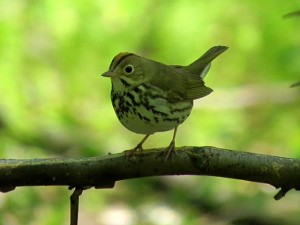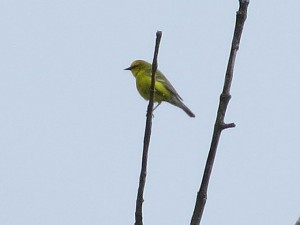Mariton: Nesting Bird Census
by Tim Burris, Preserve Manager. Photos by Carole Mebus.
Ovenbird
We conducted the annual Nesting Bird Census on Saturday. We counted 45 species and 233 individual birds. I am really happy with this count. Some of the highlights were the 20 Ovenbirds and 16 Wood Thrushes that we tallied. I use both of these species as barometers of forest interior health. The effects of Hurricane Sandy left a lot of open areas in Mariton’s forest and increased the amount of edge, for the time being. I wasn’t sure how that might influence the nesting of some of the forest interior birds. So far, so good.
Blue-winged Warbler
One of the things that I feel is definitely a result of Hurricane Sandy is the two Blue-winged Warblers that we counted. While it may not seem like a lot, it is more than we have counted in over a decade. Blue-winged Warblers inhabit brushy habitats and forest openings. We usually count one in the meadows on top, but we also counted a male singing in the blow down below the Bird Blind area. Another brushy habitat specialist are Eastern Towhees. We counted 8 this year. That number isn’t totally out of the ordinary, but some of the new places that we counted them this year are in areas affected by Hurricane Sandy.
Mariton’s Nesting Bird Census is conducted by volunteers on a June morning when it is assumed that birds have finished migrating and are settled in to breeding territories. We walk along and count the birds that we see, as well as the ones we hear singing. We have been using the same walking route for many years. We know we don’t get every species and every bird, but it is a good snapshot of what is here. For instance, females don’t sing (they may have calls), so when we count singing birds, we are only counting males. We can assume that they are with a female, but don’t count the extra bird unless we see her, or hear the call. Some birds that nest early get silent because they are busy tending to young and don’t need to proclaim their territories. Some we flat out miss. On Friday, I had a Hairy Woodpecker, a Yellow-Throated Vireo and a Black-billed Cuckoo while walking the trails, but we didn’t hear or see them on Saturday, so they didn’t get counted.
Even though it is just a snapshot, Mariton’s Nesting Bird Census can tell us a lot about our forest and change over time. This census has been conducted annually since 1981. In 1988, they started also counting individual birds. Over three decades of information that is very revealing!


